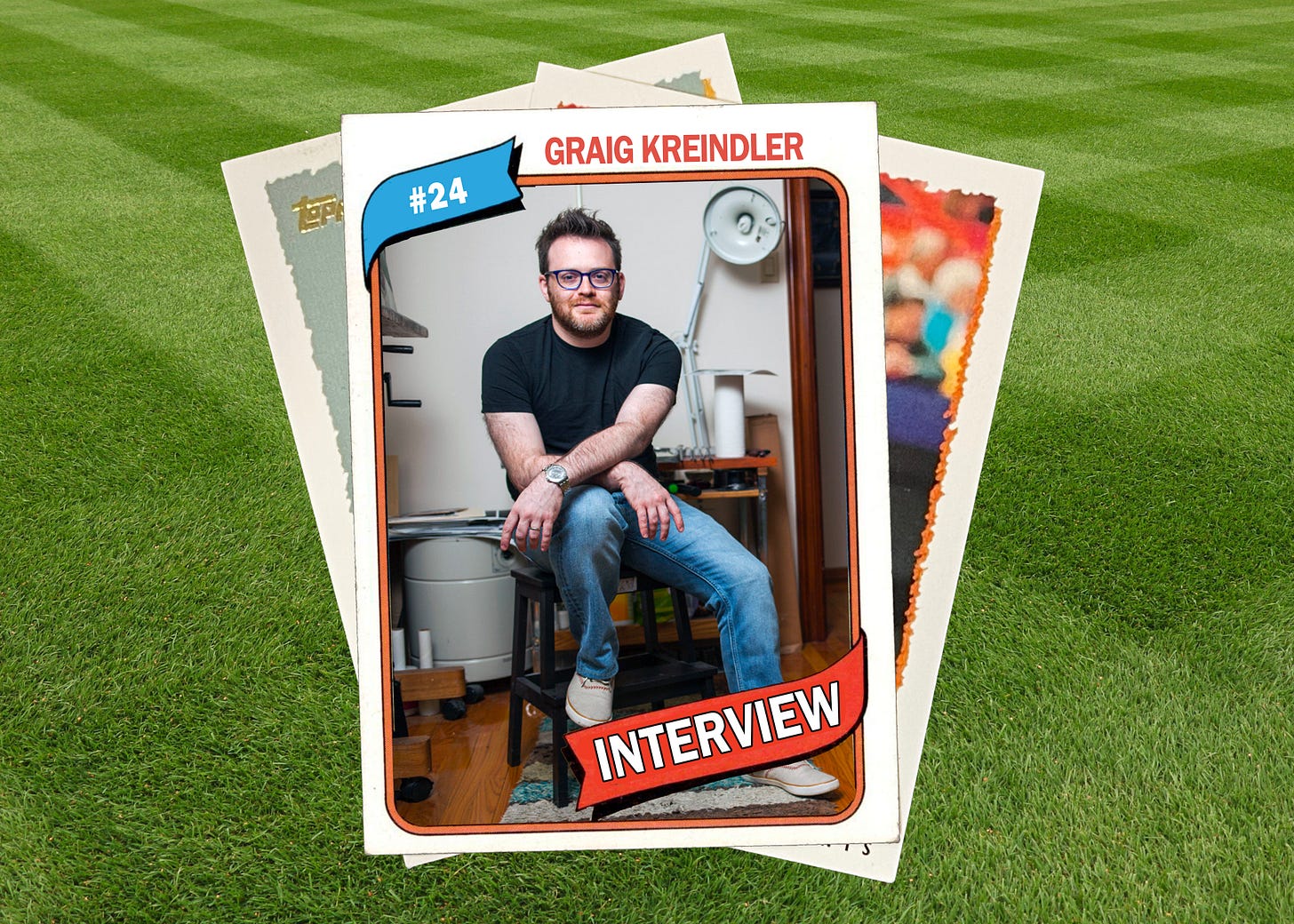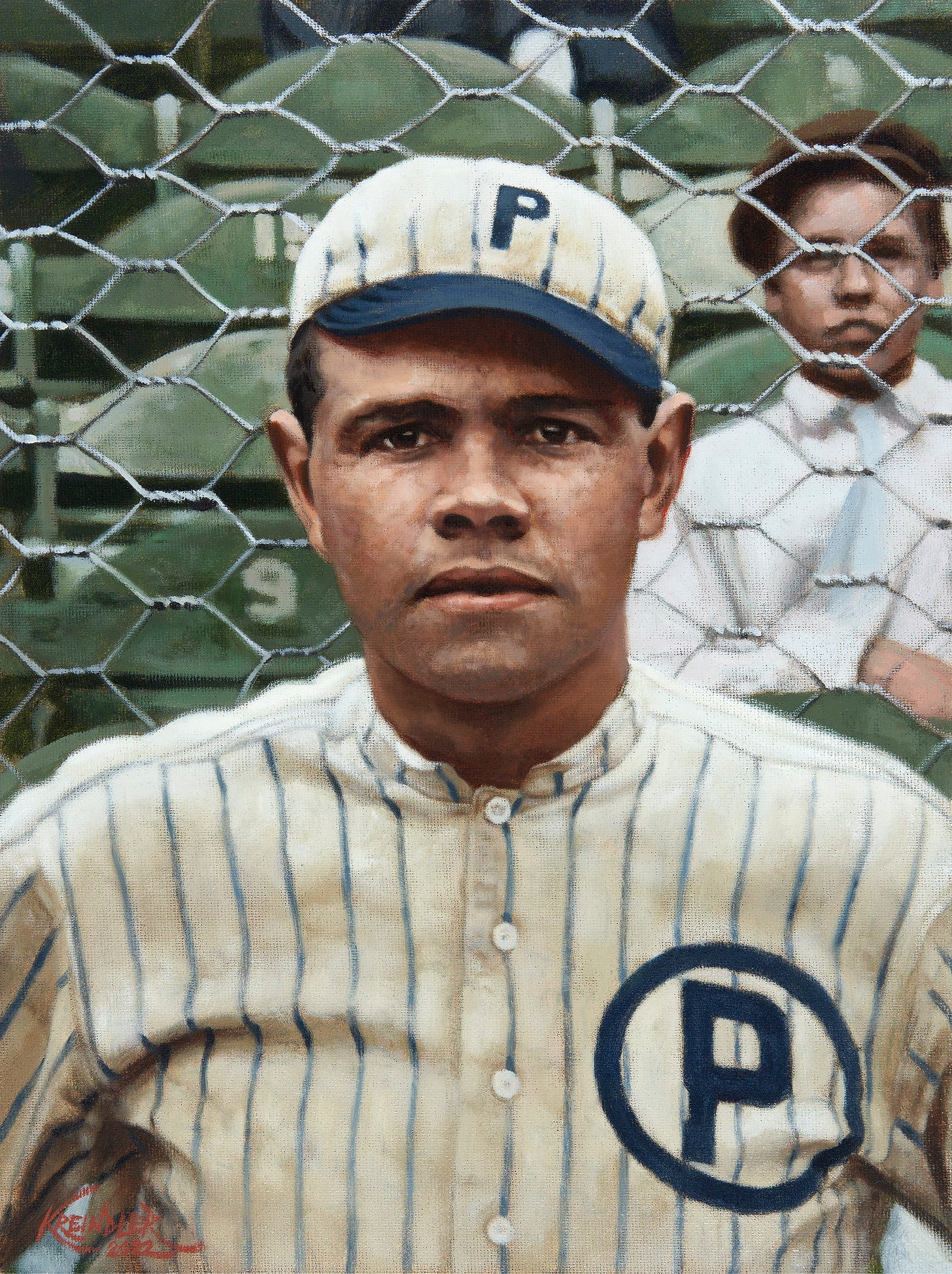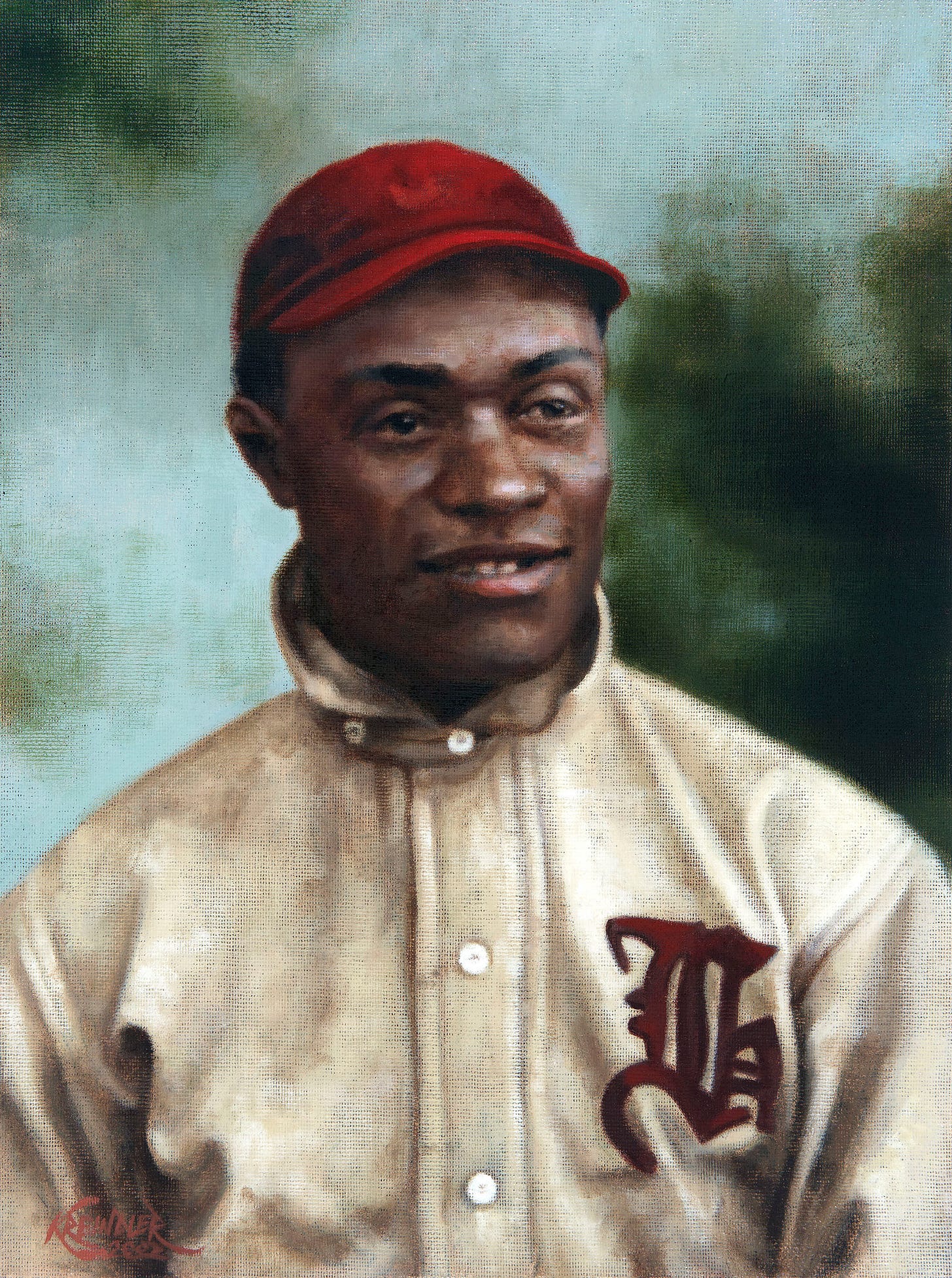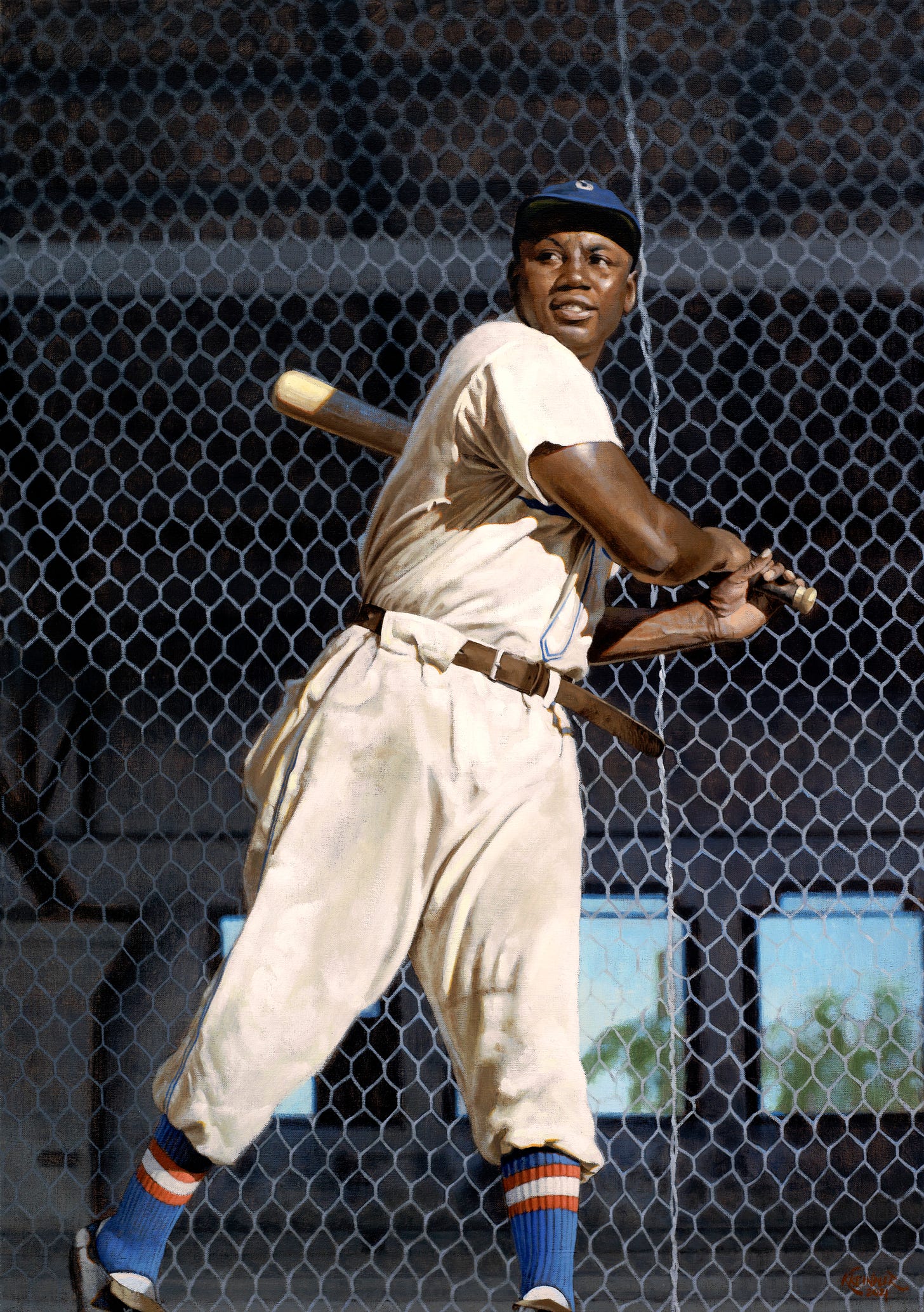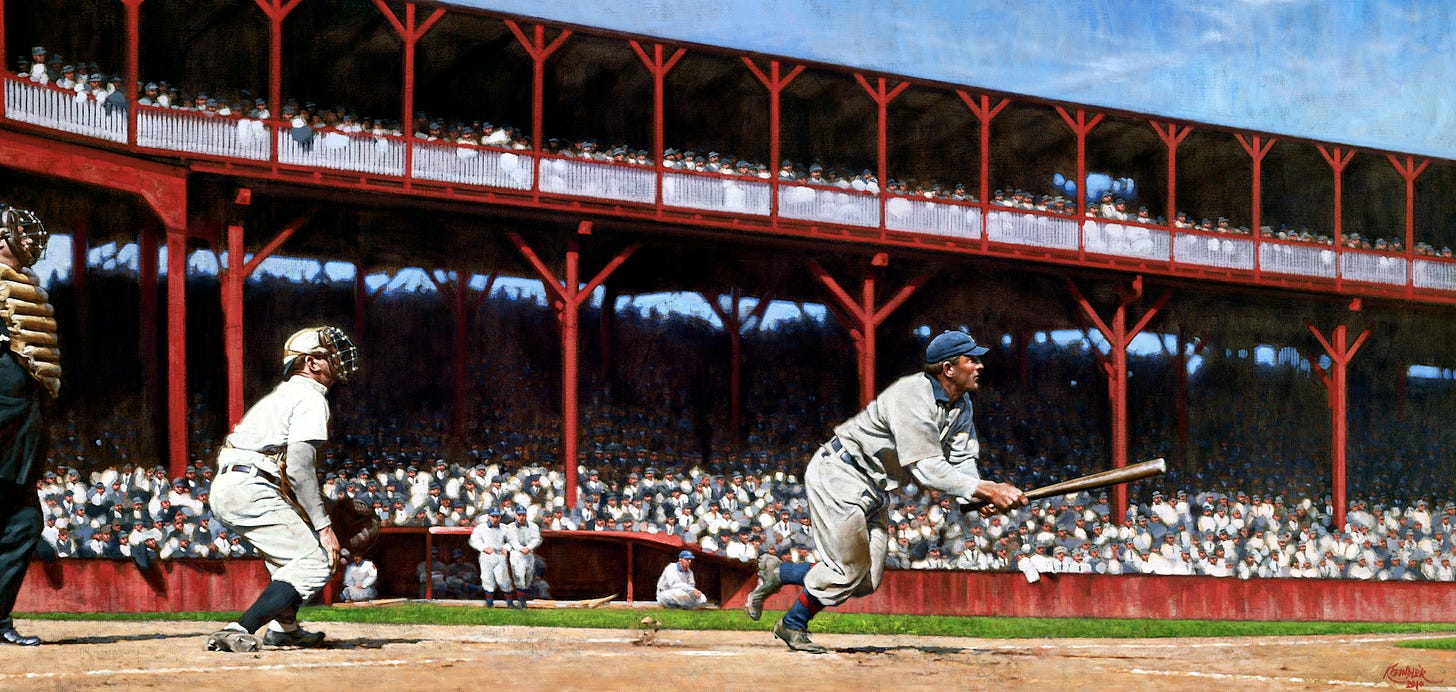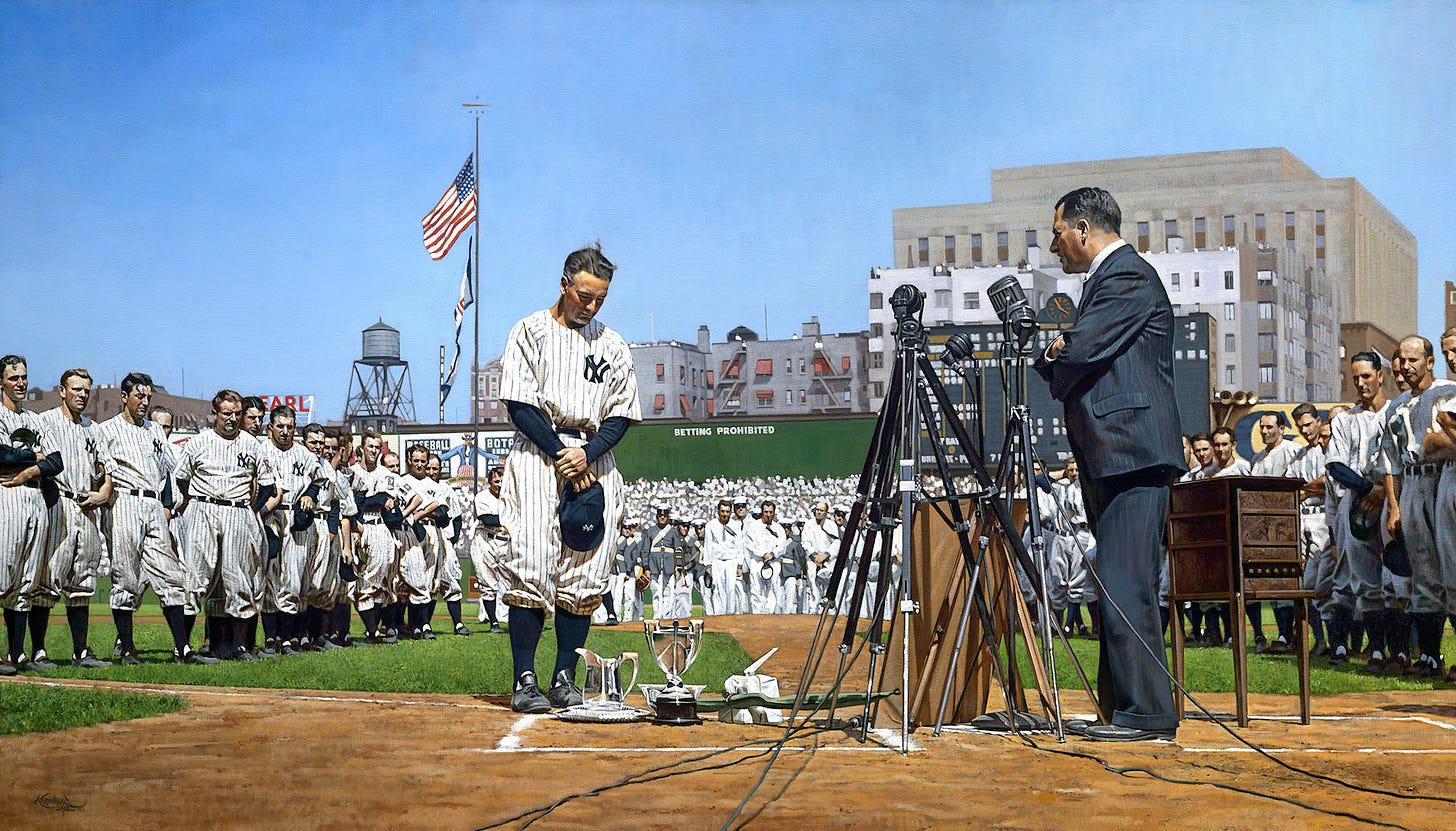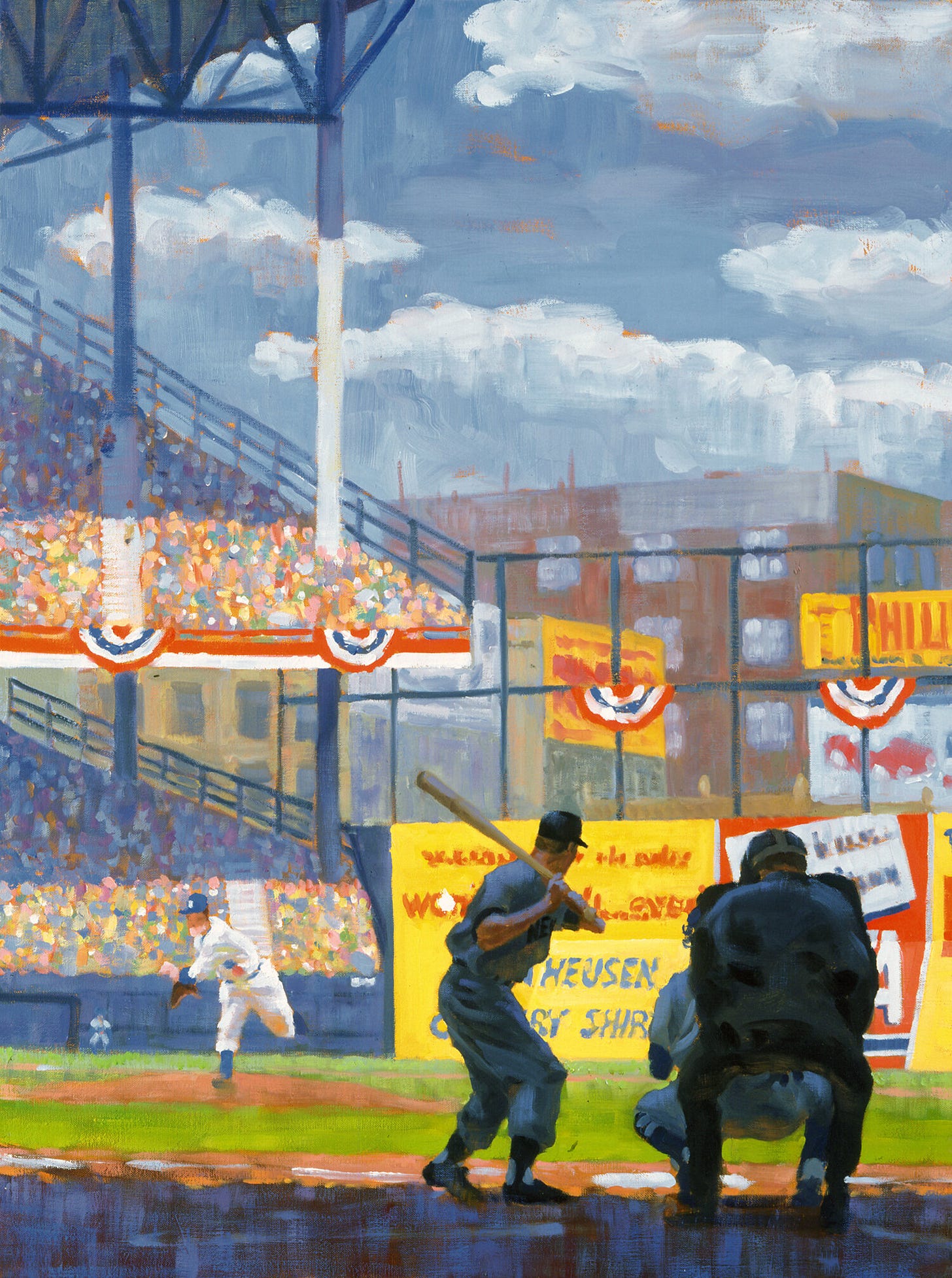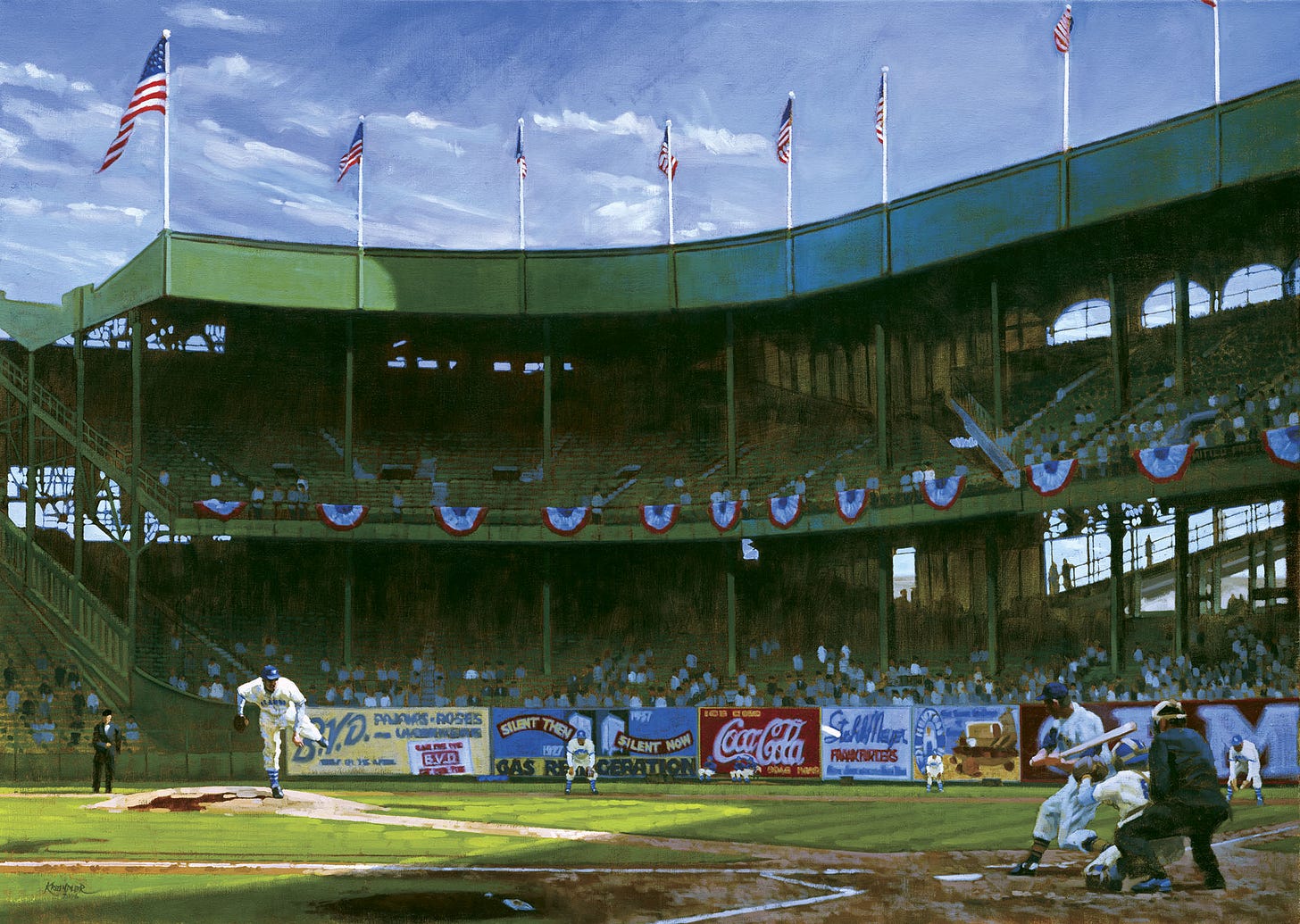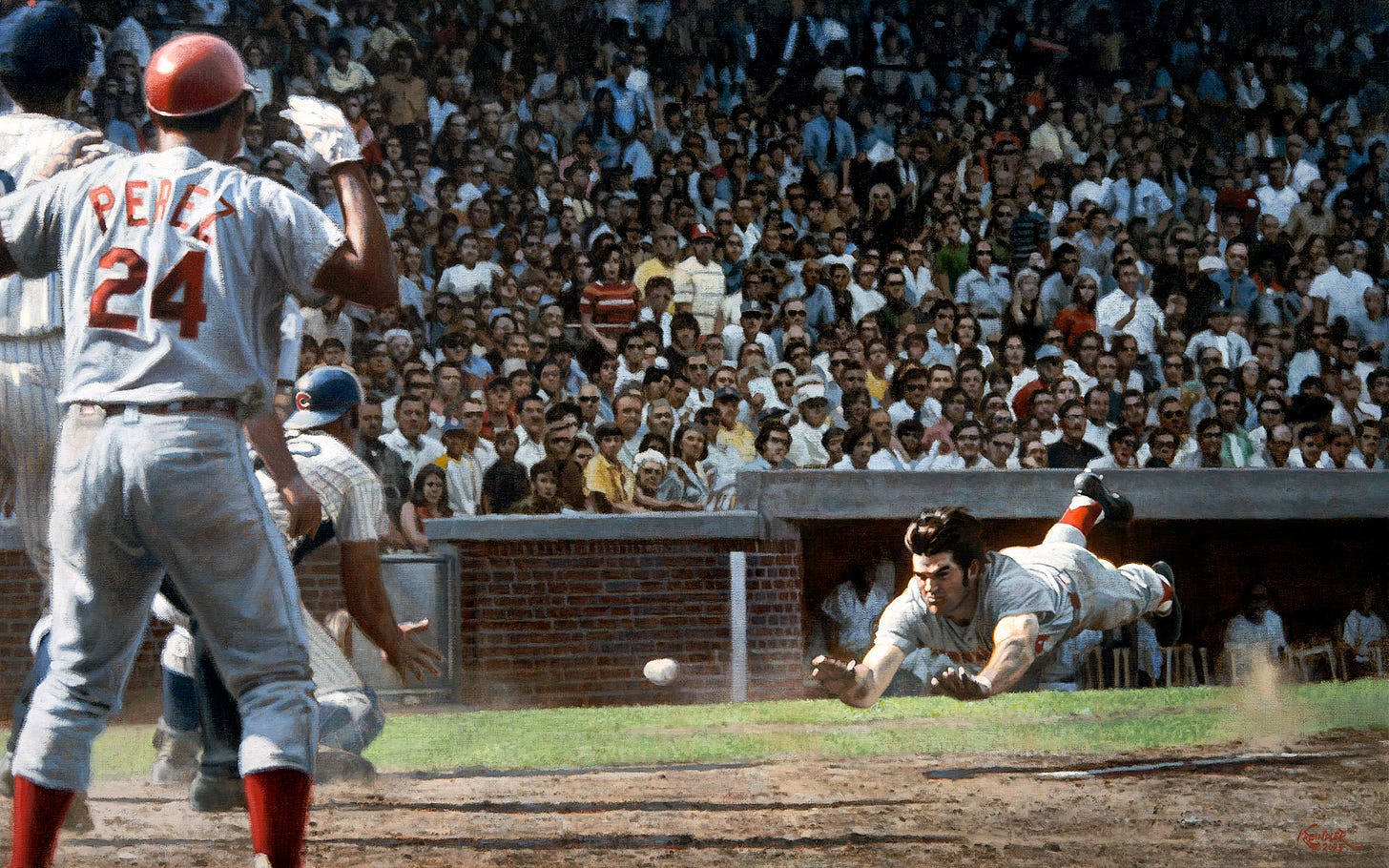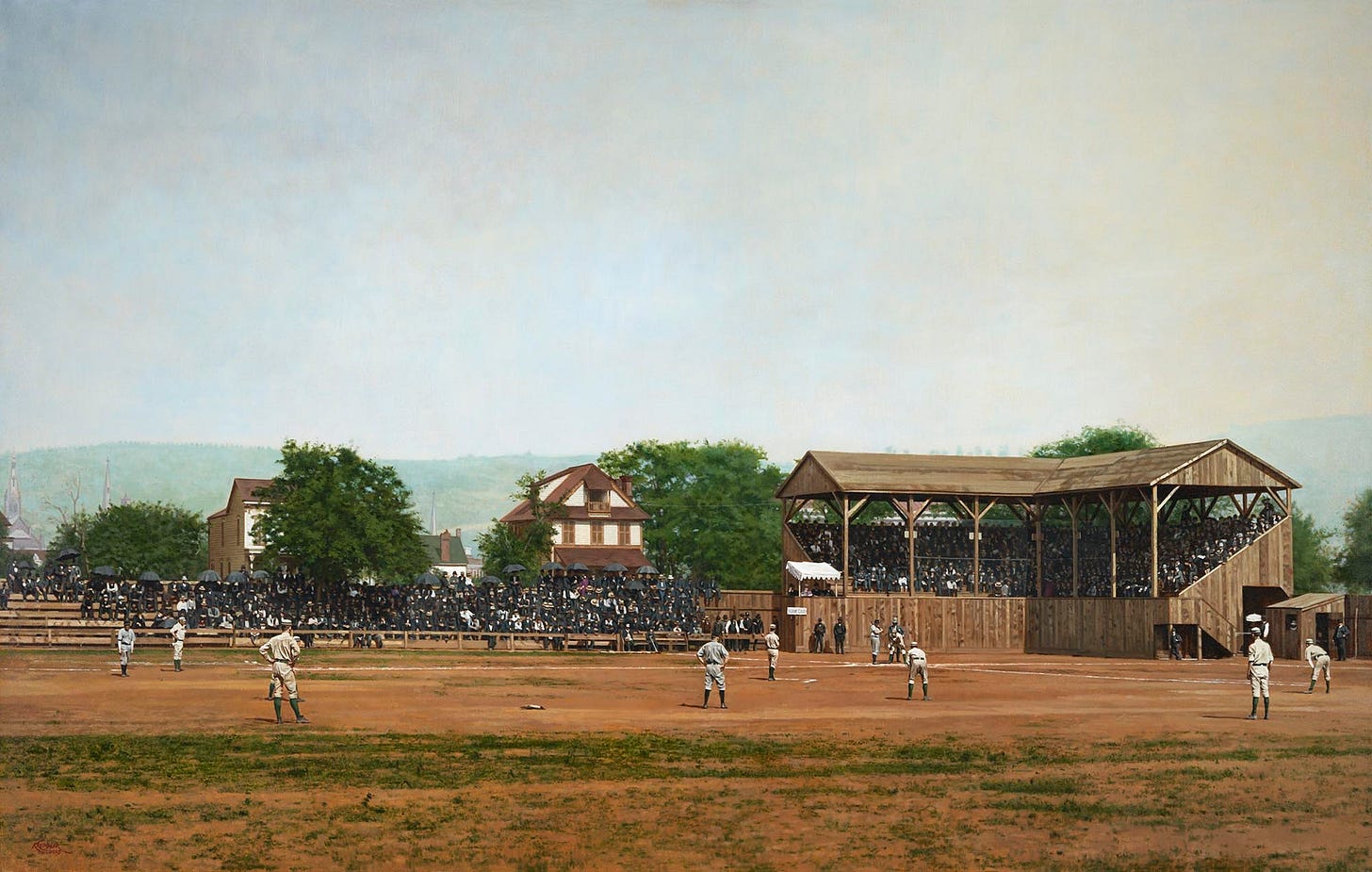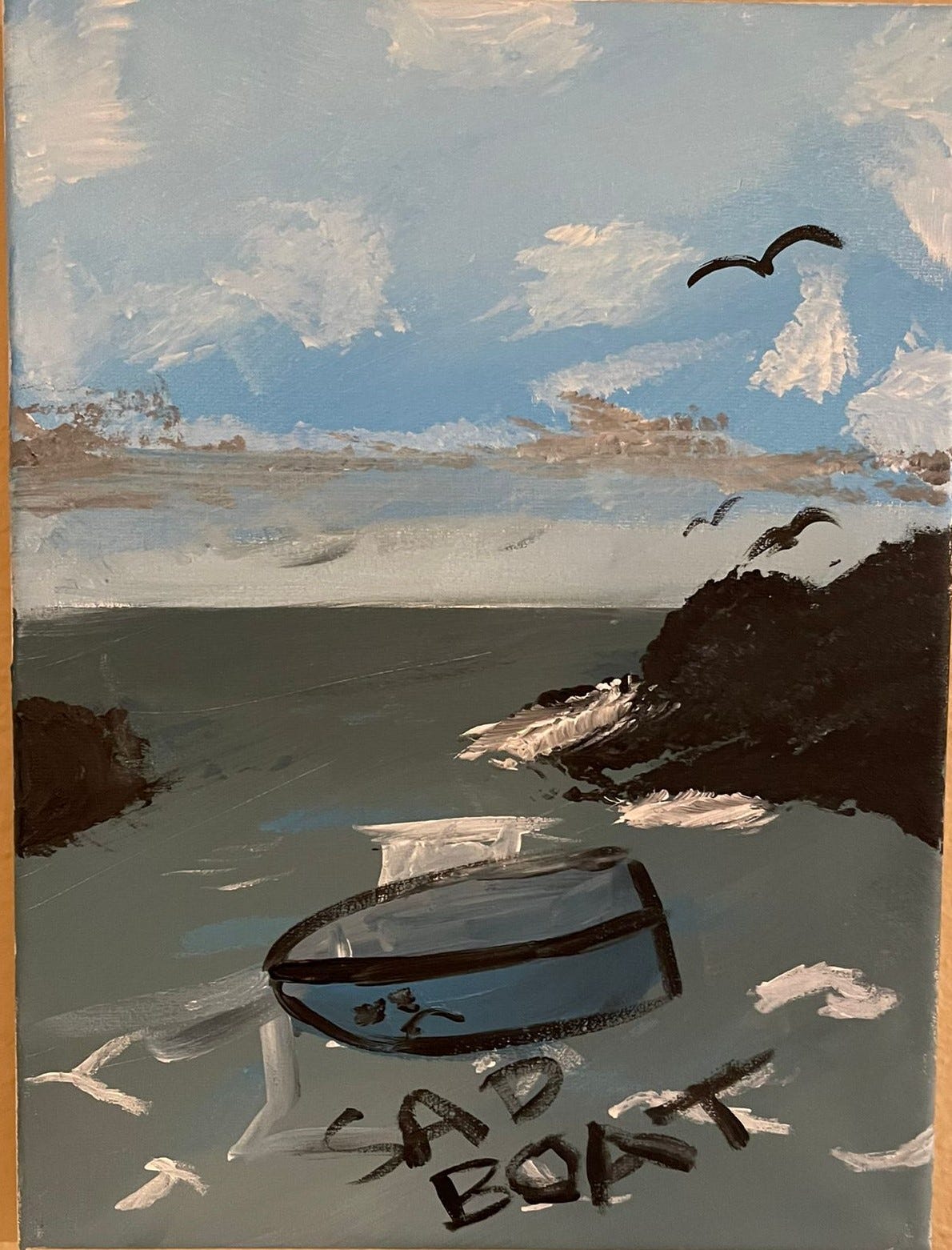Intro
Graig Kreindler is an award-winning artist who is known for his detailed and accurate recreations of baseball players and moments from all eras. His full portfolio is at his website: Graig Kreindler. He grew up near New York City, born in 1980 to two baseball fans and fell in love with art and baseball at a young age. His story shows that when persistence and hard work meet opportunity, anything can happen if you’re prepared for it. Hearing how he got to this point where he gets to make a living doing what he loves is a fascinating read. Obviously we first talked about having the name “Graig” on our birth certificates.
A Fellow Graig
“Hey, Graig, how's it going? Were you named after Nettles also?”
Yeah. When he was a Padre. I'm from San Diego.
“I was when he was with the Yankees, so it makes me think that you're maybe a little bit younger than me.”
‘86.
“Oh, OK. Yeah, I was born in ‘80. It's funny, when I was younger, I remember writing to Graig for an autograph request. And he sent me back a couple of postcards of him, one with the Expos and one with the Padres. And I was like, Graig Nettles is on the Padres?”
So you obviously have also had to tell people how to spell your name over and over again.
“Yeah, I mean it's been going on since I was little. I've gotten to the point where I just don't even care anymore. Maybe I got to that point a long time ago. I have friends who I've known for 10 years, 10-plus years, who still think my name might be Craig. So it's like, whatever, I'm done correcting people.”
For me school was the worst, because I was shy in school, so every first day of school it was this long conversation with the teacher about how to spell it, how to pronounce it. And by the time I was in, like 8th grade, everyone knew the drill.
“Yeah, you get to the point where you know the new teacher, they're calling roll for the first time. They're taking attendance and it's coming up to your name and then they look at it and they pause. And the question is usually, ‘Is it Greg or Craig?’”
Exactly.
“Yeah, that still happens.”
So you're from New York?
“Yes. I was born in New Jersey. But I grew up in a suburb right outside of New York City. And now I'm in Brooklyn. I moved here 2009 or 2010.”
OK, so you've been the Yankee fan your whole life then?
“Yeah. My dad's a Yankee fan. And my mom was actually a Brooklyn Dodgers fan, yet they somehow were able to get together and been together for 50 years. I grew up a Yankee fan. I, kind of like a lot of us, am just kind of fascinated with the history of the sport. Though I would root for the Yankees, I still kind of love all of the teams and paying attention to what's going on, or trying to pay attention to what's going on. I'm more interested in stuff that happened 80 years ago than I am in what happened yesterday.”
So your dad must have been a big fan to give you that name. Were you into baseball at a young age? Playing? Following?
“Yeah. I have to give my mom credit because my mom was the one who suggested the name. I think she saw it on TV while my dad was watching, oh, I like that name, and I like that spelling. It's interesting. And my dad is like, yeah, that's great. Let's name him Graig.
Baseball was a very big part of my life, especially growing up I went to a lot of games We would go every summer to a couple of games. My parents still swear that I went to my first game when I was like six or nine months old. I played Little League very poorly. I collected baseball cards. I was really amazed by my dad's baseball card collection and his stories, because at the time, in the 80’s, the Yankees, though they had a pretty stacked team, they they didn't make the playoffs after ‘81 and I think in my head that meant that they just weren't a good team.”
“So you know, my dad would, it's like I’d sit down on the proverbial knee and he's telling me about Mickey Mantle and Yogi Berra and how things were in his day. So I really connected with them. You know, as much as I loved Mattingly or Winfield or Righetti or Guidry, I also loved Mantle and I loved Ford and Berra. And they seem just as vibrant to me as the stars of that day and I was kind of obsessed. The fact that my dad had a, still has it, one of the cards that his mother did not throw away was a 1951 Bowman Mickey Mantle rookie card. And I knew that it was worth a lot of money back then. And even though my Dad’s card was in terrible condition, what amazed me about it, not so much that it was an expensive card, I mean, that probably helped a little bit, but my dad had a lot of sentimental attachment to it.
And it was really special to me because of that.”
The Paintings and Process
Yeah. So I can tell you have to do a lot of research into your paintings, just with all the detail that goes into them. So you enjoy doing that part right? There's two steps, right, you've got to research your subject and then paint it.
“Yeah, yeah. And those two kind of go hand in hand. There's a lot of overlapping, too. I love the research part. It can be maddening, because I'm a perfectionist and I want everything to be historically accurate. So if I'm second-guessing the color of something or whatever, then I'll always try to find ironclad evidence of whatever the color of this something should be. It's not easy to do sometimes, the further you go back for sure. There are times when I paint something and I'll kind of be in the middle of it and then I'll still be doing research and be like, oh, well, it looks like I made a mistake here because this should be this color instead of that color. And that happens all the time.”
So have you gotten all the way done with a painting and been like, Oh no, wrong shade of blue or something?
“Yeah. There have been a couple of times, actually. More than a couple, where I'll call or e-mail a client out of the blue. Someone who purchased the painting, and they've had it for a year or something. And I'll be like, hey, I just realized that I made a little bit of a mistake here. Can you can you send the painting back to me? I'll pay for it and everything. And I just want to correct it and then I'll have it photographed and send it back to you. I have a painting in the studio now that I corrected this past month. Gosh, guy’s had the painting for seven years maybe. But yeah, I have problems.”
What do you use for your research? Do you have contacts with researchers or historians? Or the Hall of Fame or anything to help?
“It's a little of everything because I have a lot of resources that I can use myself. Whether they're newspaper archives or whether I can just search online for home movies or whatever. There are also historians that I can contact or the Hall of Fame. I do my own research and there are lots of wonderful avenues I can go down because of the Internet.”
I'm looking at the Negro Leagues project on your site right now and that's got to be really tough because there's very little photo evidence and very little people who have direct knowledge of it anymore.
“It was a project that I did with a collector out in the Pacific Northwest and he commissioned a ton of paintings of various Negro and Latin American League players. It ended up being a four year prep then I did it almost 240 paintings and they're all they're all 5 by 7. So they're small and they're all portraits. Just finding actual photo reference of some of these men and women was really, really hard and finding color information for a lot of them. A lot of those studies that I did for that client, I would now change because I've discovered other stuff that isn't as accurate as it could be.”
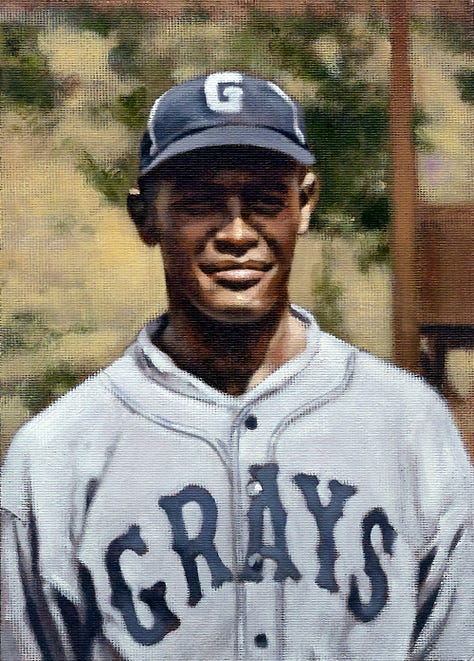
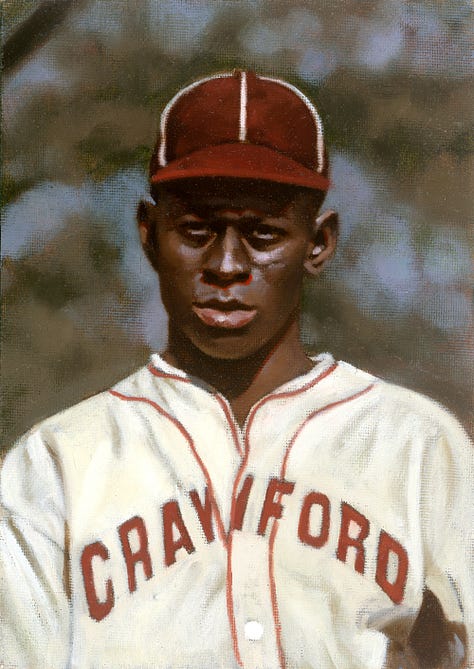
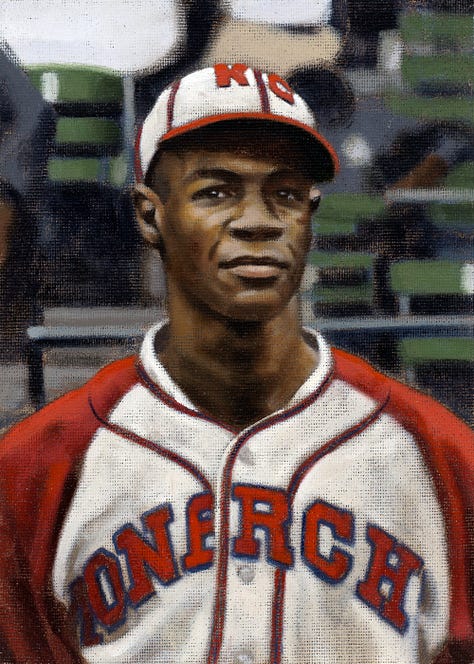

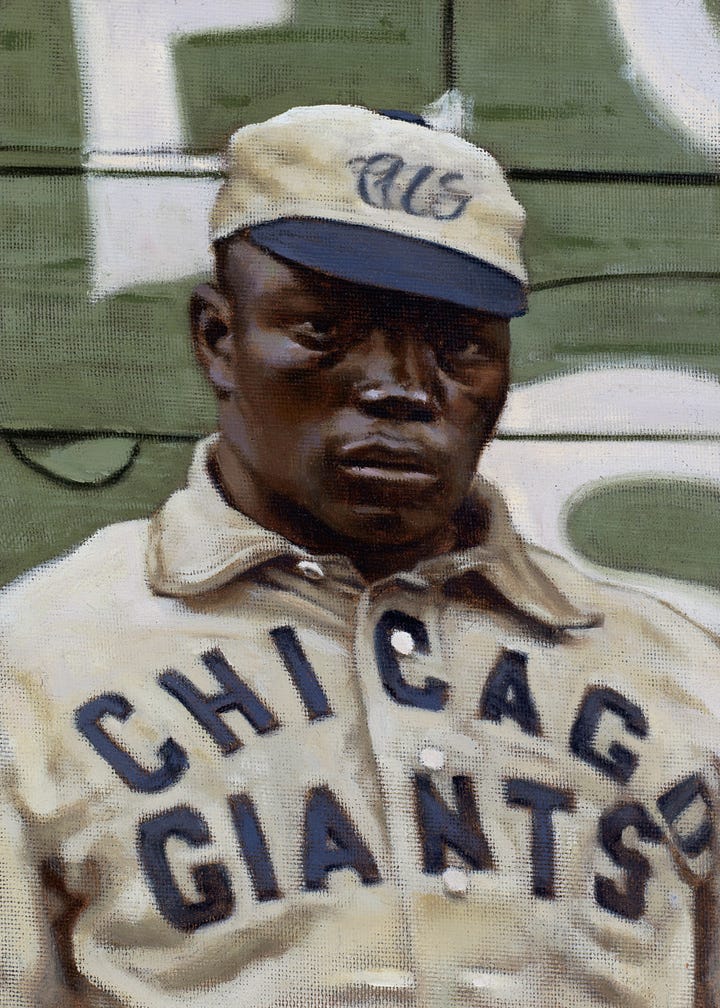
I didn't notice.
“It's perfect. Then everything's perfect. I mean, I obviously love painting in general, but I love painting these baseball players and I love the painting the historical stuff because it gives the opportunity for people to see these players in a completely different way. People our age, even people my father's age, when you think of Babe Ruth, you think of him in a black and white grainy photo. But in reality, it's like Babe Ruth breathed the same air that we all breathe and he was in color. So giving people the opportunity to see that is a lot of fun for me.”
When I'm looking through and I see your paintings with the old ads in the background and the crowd, so those must drive you nuts because you must look at something that nobody would notice unless they're, like, just looking at it one day, like, hey, that guy's hat looks weird or something.
“All the time. My new show, there's this one painting I did of Honus Wagner, and he's batting in West Side Park, which is where the Cubs used to play before Wrigley Field, and the painting is depicting him doing this in 1909. The grandstands behind him are this red color and I had to do so much research to find out that that was historically accurate. You know, I could have just painted them the typical ballpark green, but I discovered that they were red and still to this day, like I, they're not nightmares anymore, but sometimes I feel like, oh, what if I'm giving a talk somewhere and there's a crowd of people and I'm talking about the painting, and then I'll be like oh, here's Honus Wagner at Westside Park in 1909. And then all of a sudden, literally a 140 year old man, waves his cane and he's like, I was there that day and you got the colors wrong. This is BS. There's always that fear.”
If that happens, that would be national news.
“It's like, you're an accountant, right?”
Unfortunately.
“It's kind of like the numbers. Numbers don't lie right? And art is not like that. I think it's not like that, but at the same time, I try to make my art as close to numbers as I can because I want it to be accurate and I don't want anyone to question it. But I also want them to see the art in it. So it's like straddling both worlds in a way.”
When I first came across Graig’s paintings and artwork, I ended up poring over all the work he’d done, marveling at the little details that brought the paintings to life. Like expressions, period-accurate fans in the stands, the scoreboards, the ballpark architecture. They stand out to me not only because of them just being cool paintings, but also knowing the painstaking detail that is displayed in each one, showing things that only the most well-researched projects could accomplish. I know the parts I do enjoy about accounting are researching things and finding things that are buried in the numbers and discovering something no one else noticed. I can tell his answers to researching these older players and constantly wanting to be more and more accurate, even after completing a painting, are similar traits.
Growing up drawing and then doing the struggling artist thing
How did that start? Were you always artistic growing up?
“So I've been drawing since I was very young, three or four. The earliest stuff that I remember drawing, I was kind of mimicking the cartoons that I was watching at the time, so stuff like He-Man and ThunderCats and GI Joe. I would tape the shows and I would come to a part that I really liked and I would pause it and then I would just draw from the television. Sometime after that, or soon after that, I became aware of my dad's baseball card collection. He was born in ‘44 and he grew up in New York City, in Queens, and he was collecting cards from the late 40’s into the early 50’s, so a lot of the Bowman and Topps issues from that era.
When I saw that stuff at that young age, I think something in my head clicked with the fact that the majority of the stuff, the majority of the artwork on those cards, they were done by a person. So I think something clicked in my head and I was like, oh I can do something like this. I could draw Mickey Mantle or Yogi Berra, and that's how it started. I would draw Mickey Mantle for my dad, he was his favorite player, and kind of do it to get the pat on the head and, ‘Good job, son.’ I feel like I was making art until around the time that I started going through puberty and got into other things. You know, like being ignored by girls and being a weirdo or whatever.”
The girls didn't want Mickey Mantle drawings?
“They didn't. But you know what? A lot of them wanted me to draw them stuff. And it was always, can you draw me a rose or can you draw me a unicorn. I drew a lot of unicorns and roses in my time. It's funny, I told my wife that, like, 10 years ago. And so she asked me to do a drawing of a unicorn for her and I did it did just like how I would have done when I was younger. It's just this unicorn on a cliff and looking majestic, and there was a rainbow behind it. And of course, a link to my website because I have to market myself. Yeah, I would draw a lot of those and then get ignored.”
Well, I hope that painting's on your mantle or something.
“Well, you know what? It was on our refrigerator for a while. I'm not sure where it is now. I should find it though and put it back up.”
Did you go to school for art?
“I had taken a couple of art classes here and there when I was younger. At the time, I was still just drawing. I wasn't really painting that much. I didn't really like painting, it was scary for me. I didn't feel comfortable with a brush in my hand. For college, I ended up going to the School of Visual Arts (SVA), which is a private art school in Manhattan. And the goal was to be a professional illustrator to do hopefully book covers for science fiction and fantasy.
At the time, that was more so the art that I was into. So I went to school there and I worked hard and learned how to paint and learned how to draw, and I’m still learning how to do both of those things. Eventually I dropped the science fiction and fantasy stuff because it just didn't feel like it was right for me. There was this idea that art was supposed to tug on my heartstrings in some way, and kind of have the romance of being in love with what you do. And with the science fiction stuff, I liked it. It wasn't my true love. It wasn't my passion. And it wasn't until my senior year at SVA that I did kind of my first mature baseball painting. And that was like, oh ok, this is what it's supposed to feel like. And yeah, that kind of started me off.
By the time I was a senior, I was worried that I was going to be leaving college and I was going to try to get illustration work, which trying to go out and become a freelancer is tough. And I was really scared about it because, basically, at the School of Visual Arts, the people who are your teachers are actually working professionals. So they're people in the business, and in essence, when you leave school and become an illustrator, the people who were teaching you all of a sudden, now they're your competition. These are the people who you're trying to get jobs over. And that's a scary thought. And for me, on top of the fact that I didn't really like doing the science fiction fantasy stuff anymore, I didn't really know what I was. I didn't know where I was going with it. You know, I was just kind of floundering.
My senior portfolio class, my teacher at the time would give out very general assignments every other week. I want you to illustrate this. I want you to illustrate that. And he gave you a lot of room to interpret it however you wanted to interpret it. He wanted us to illustrate a relationship. And for whatever reason, one of the first things that came into my head was the relationship between a batter and a pitcher. And I went with it and I was thinking, this is kind of like what I used to do when I was younger. I'm thinking, OK, I'm a better artist than I was when I was 8 or 9, so why don't I try and do a painting for my dad? Why don't I do this painting of Mickey Mantle? He's still his favorite player and Dad will get a kick out of it. So that was what I did and at the time I was pretty well aware of the fact that baseball fans are super anal about everything. And I knew that if I was going to paint Mickey Mantle, it had to really look like Mickey Mantle. He had a distinct look to him my father would certainly notice that.
When I would bring in my drawings when I was younger, he’d be like that doesn't look like Mickey Mantle. And I’d go and cry and tell my mom and my mom would give me all the love and affection. But I mean, he was right. It didn't look like him. So my dad fed that perfectionist side of me. I was aware of the fact that Mickey Mantle had to look like Mickey Mantle. So I got into the whole researching aspect of, what does Mantle look like when he's batting from the right side rather than the left? Where can I put him? Can I illustrate like a specific at bat? Where did that at bat take place? When did it take place? What time of day was it? What was the weather like? It was just a really deep rabbit hole that I fell into and I loved it. It was just awesome. And now it's kind of like I’m still in that rabbit hole.”
“I mean, I didn't have to do any of this kind of research. The only part of the assignment that he wanted us to follow was that it was just illustrating a relationship. I was able to take it a couple of steps further and realize that if I'm going to do like a batter and a pitcher, especially if I'm going to do Mickey Mantle, I have to put more leg work into this and it was the first time that, when I was doing research for a painting, it was the first time that I really enjoyed it. Because otherwise it's like, OK well, maybe I'm painting a pirate on a Spanish galleon or something like that. And what did the Spanish galleons look like in this era? What would their clothing look like? And I mean, that was kind of cool to research that stuff, but the baseball stuff was really cool to me.”
So what kind of reignited your baseball passion. You’d done that college assignment, right. And around that time is when the Yankees dynasty in the 90’s was at its peak. So you couldn't have ignored the Yankees at that point?
“I remember ‘95 pretty well and the playoff series against the Mariners and the disappointment of how that ended.
I remember ‘96 and the three-peat (1998-2000), but still, I was only kind of half paying attention to what was going on. Mainly I think because I was still just immersed in my college work and trying to make a career out of that. It hadn't yet met with the baseball part, but even then, you know when it did meet, I still was more interested in the stuff that had already happened. I did this painting of Mantle and probably soon after was when I saw the Ken Burns documentary. I don't think it was for the first time, but it was definitely the first time that I was paying full attention to it.
And I just fell in love with all of the stories that were being told. HBO had a series of specials called When it Was a Game in the early 90’s and those changed my life because watching those and seeing Mickey Mantle in color and seeing Ebbet’s Field and all that stuff. That changed my life. You know, coupled with my dad's stories, that was like, ohh, this was real history and it happened, and it happened in color. It was just something as simple as that, and still to this day it pulls on some serious heartstrings for me. Then I do my own research and get lost in the weeds with everything that I'm reading about.”
So when you got started what was it like? You're graduating, you need to find work, right? What was it like during that time for your professional career? And then was the baseball side off to the side for a bit? What were the first few years after college like?
“They sucked. So I was very lucky in that my parents have always been super supportive of me and my brother and super supportive of our decisions and the fact that I was pursuing art. So college is over, I moved back home, and I'm very lucky because I don't have to pay rent. I have a few expenses here and there, but not many. And I was really spoiled in that regard.
I ended up getting a job at a local pizzeria. I basically did that to make money. And I would paint when I could and I would send out promotional materials to art directors when I could. I got a couple of bites here and there. I did a couple of jobs in those couple of years, certainly not enough to sustain a career. Maybe every six months or so I was doing a job and getting paid. Less than a grand maybe, $600, $750 or something like that. And nothing was really happening. I wasn't really getting any traction. I was still doing other kind of artwork like general illustration. But come 2005 or so, I'm frustrated. I've been out of college for about 3 years at that point and I wasn't really getting any traction and I didn't love it. I mean, the only thing that I was really enjoying was the baseball stuff. But nothing was happening with it. And I decided I was going to go to Lehman College and get certified to teach art. My parents were teachers in the Bronx for 35 years, both of them, and I figured teaching is probably in my blood. And I got to do something. I don't want to stay in their basement my whole life. We got to make a living. So I went to Lehman and I took all the classes that I needed to take and I got certified to teach art.”
When he talked about the struggles after college of trying to find work, not making it, eventually shifting focus to teaching after a few years, it shows how much groundwork you really need to make it in one of these competitive career paths. Just like a baseball player honing his talents on some remote single-A practice field, putting in all that work without an audience is what allows you to be ready when you do get your shot. Which was my favorite part of the interview, because he was basically resigned to having this passion project be a side hobby that was more of a relaxing break than anything he’d do for money, just like how I treat this blog and really any writing project I’ve ever tried. I do it, and some people see it, some people like it, but at the end of the day I’ve gotta crunch numbers to pay for groceries. But he kept at it.
The Big Break and staying successful today
“By the time I was close to graduation, something crazy happened. We had a family friend whose wife at the time was a writer. And she thought that my story about all the baseball painting was a very interesting story, so she wanted to write a profile on me. And I was like, OK, whatever. So she came over, she talked to me, did a little interview. I still remember this so well and, You know, I didn't think anything was going to happen. But a couple of months before graduating, I get a call from her and she's like, so the story about you sold, and I'm like, oh, cool, not thinking anything of it. She said it sold to The New York Times and it's going to be in the Sunday Arts section which, if you're an artist, it's life changing. There aren't many ways to legitimize your work more than something like that. I still felt some serious imposter syndrome because at the time, I was 27, when it came out and what the heck are they writing about me for? Write about my teachers, who were incredible artists, people who should be in there, not me. But I was in there and people discovered me. They discovered my work. I sold work, I got commissioned work, I got an agent out of that. All of a sudden I'm like, OK, well, I'm not going to teach right now. I want to see where this art thing goes. Because now I'm actually getting money for it and really enjoying it. Let's see what happens.
And honestly, since then, I mean certainly there have been ups and downs, but it's been non-stop since 2007 since that article. It absolutely changed my life. Not only did it legitimize what I was doing to other people, other people saw the work and the New York Times is writing about it. It must be important, but it legitimized it to me and made me think, oh, well maybe what I'm doing, not that it's important, but maybe what I'm doing is cool and has value. I ended up not teaching. I've been making a living off of my artwork ever since, which is insane.”
So you're 27 when that break came, that's 6-7 years after college. That's 25 years of drawing, painting, being an artist. How did you get through the period where you had the highest amount of doubt, like maybe I'm just going to deliver pizzas forever? Did you ever give up? Or did you just kind of power through it?
“When I had decided that I was going to go back to school and try to become an art teacher, I took a break from painting. I didn't paint anything for many months. And I I didn't know if I was going to come back to it. I kind of hoped that I would, but I didn't know. I would always just try to power through in some way after that. I think slowly, since I was doing the art stuff and trying to get certified I obviously had to take art classes and a lot of them were painting classes. And I was thinking, OK, well, maybe this will kind of get me back into it and I can still do my baseball paintings, but I'm not going to try to do anything with them. They're just for myself. I think when I stopped putting pressure on myself to try and make a living off of it, it helped. What helped me was that I went to a really good art school and I had a bit of academic training in it, so I was doing well. That started to give me more confidence just in general, that I could paint again, but still, maybe I'll just be a teacher and I'll just be able to paint somewhat well or competently and that's it. But the Times thing just changed everything.”
So what you really love, which is the research and the painting, was that also what kind of kept you doing it when you weren't getting paid for it?
“Painting itself for me, I do enjoy it, but if I'm not painting something that I don't have an emotional connection to in some way, or any connection to, it's really hard. It's hard for me to get it done because I just don't care as much as with the baseball stuff. Maybe a part of me was like, oh, well, I'm painting these guys that no one has thought of for 70 years. When I was at Lehman and gotten over the hump of painting or not painting, I started a painting of Carl Hubbell, who became my favorite player of all time, or one of my favorite players of all time, and it was just this huge painting of the Polo Grounds, Carl Hubbell, 1937, Opening Day. Someone asked me, ‘Why are you painting Carl Hubbell? You know you’re not going to be able to sell that. No one even knows who that guy is.’ And I was like, I don't care, I love Carl Hubbell. I want to paint it. And I want it to look right. The love for painting baseball stuff was always there. Every now and then I'll do a painting of something that's not baseball related, like, for a friend or something and they want like a painting their parents wedding or something. I'll begrudgingly do it, and I'll probably hate every second of it. I just want to get back to baseball.”
So ‘07, that era was like your big break, you're getting commissions and selling work, that was before the social media boom. Has that helped at all? Have you met people that shared your passion and has this career been able to connect you with those kind of people through social media?
“Social media is a huge part of it for me. I mean, when I was first doing these paintings, there was Friendster and there was MySpace and that was about as social media-savvy as we got. But having the ability to connect with people all around the world who have similar interests, that's worth its weight in gold. To me, that also changed my life just being able to get my work in front of so many more people than I would have been able to before.
Now, on Twitter (note: I refuse to call it X) or Facebook, there are people who I can message out of the blue and talk to about an obscure 19th century player that isn't in the Hall of Fame who has been long forgotten and they'll be an expert on this person, and I can ask them questions and at the same time I'll think, oh, well, this person's an expert on this person. There's obviously something compelling about that. I should paint that person or something like that. I also think social media is a horrible thing, so it's kind of the double-edged sword thing I guess.”
Luckily, the baseball side tends to be a little nicer.
“A little.”
Sure, as long as you're not a fan of the Astros.
“I think overall you have a lot of great fan bases, but you also have a couple of people who just suck in general and they can take a lot out of you. I mean, every now and then I get abuse on social, just whether someone is criticizing the work or they're like, you can just take a photo or whatever. It comes with the territory, whenever you put yourself out there, you're going to have criticism.”
It's got to be overwhelmingly positive feedback though, right?
“It is, I'm very happy about that. But you know, one bad comment among 300 lovely comments can ruin my day. It takes a lot less energy to be on social media and write something mean than it does to be positive and supportive.”
What’s something that stands out? Like, I can't believe that I got to do this because of this career.
“I've been able to kind of connect with a lot of wonderful people and I've made a lot of friends because of this. I'm not saying this to brag, but some of my clients are people in Hollywood. It's kind of cool to think, I have something hanging in there and it's something that they paid for, that they wanted me to do for them. The first thing that I thought of when you asked that was this time, I think it was in 2018, where the Saint Paul Saints put a baseball museum in their ballpark, and they had a painting of mine in there that they had commissioned me to do. They flew me out along with some of the other people who contributed to the museum for the first game of the season and they opened the museum and me and about six other people on the field to throw the ceremonial first pitch. That was really cool. But really the best part of it is just to have friends who are just into the same weird stuff that I still like.
Every year I go to the National Sports Collectors Convention, which is basically like the biggest baseball card show or memorabilia show of the year. It happens at the same time every year. I go every year and it's my favorite week of the year because I get to see so many people who are just into the same stuff that I'm into. They're passionate about the same stuff and we get to kind of nerd out together. That's super rewarding to me. So I love that part of it.”
“But I mean everything about it has been wonderful. I'm really lucky to have a career doing something that I love. I'm not starving for work, I have have a very long backlist of commissions that I have to do, and there are a lot of artists who would kill to have that. It's job security, which is crazy. I just feel blessed and so thankful for it. You know I’m always kind of worried that eventually I'm going to get the knock on the door from somebody saying oh, you know Graig, you've been dicking around for 15 years. It's time to go out and get a real job. You're not fooling anyone anymore.”
So you still deal with that imposter syndrome a bit.
“Always. It's not even a bit, it's forever and always.”
How do you get through it?
“People who say nice things about my work, they're really lovely, and I really appreciate it. But I always want to say something, like, you think this is good? I mean, have you seen so-and-so's work, like that's real artwork. That never leaves me. I'm also really neurotic, so that probably doesn't help.”
But if you're being honest, you would say you're a better artist than you were. If you put aside your own self doubt.
“I guess. I mean, the thing is I don't really think of myself as an artist. It's weird to say that.”
What do you think of yourself as?
“More like a painter, I guess. Or maybe not even a painter. I think that there's so many other people who are doing spectacular, cerebral artwork and the varying techniques and different kind of reasoning for doing it. And for whatever reason, those people always come off to me as being more of an artist than I am. It has nothing to do with a level of success. It's just how they approach the work and how they think of the world. And to me it's just like, I just want to paint baseball and do my thing and I'm happy that I'm doing well, but, I don't know.”
Even after he’s achieved so much since getting that article published, he still doubts himself. Which I’m sure is healthy in small doses, it keeps you striving to get better. If you just looked at his art, you would be convinced this is a confident person who knows his craft inside and out, having forged a path bringing long-forgotten baseball history back to life. But then you realize that just like everyone else, he’s just as worried about failure and being revealed as an imposter as any other creative person. Except he really is good, if you can’t tell from the works he shared for this post.
The Importance of Having a Support System
You have kids now, are they into baseball at all? Or your wife?
“No, actually they're not. My wife is not into baseball. And my kids don't really have much of an interest, which is fine. I'm actually a little surprised that I'm the only one in the family that is interested.”
When did you meet your wife?
“I met her before that Times article came out. I met her in the summer of 2006.”
OK, so she didn't think you were some weirdo painting in your basement with baseball pictures everywhere?
“Oh, she absolutely did. I lucked out because my wife is a writer, so she is very much of the same mindset and, you know, needs her time to work and be creative and be in her zone and read books and all that. So she totally understood where I was coming from with that. So we work very well together because of that. I'm sure she still thinks I’m weird, though, but at least I'm a good weirdo.”
So having her in the same kind of industry, when you were going through ups and downs and she probably went through ups and downs, were you guys able to support each other then?
“I mean, just honestly having having somebody you can talk to about that stuff, even if it's just to kind of talk it out and verbalize it, it is so helpful. But also I can talk to her about complaints I have with like a client or how I’m feeling about something and she gets it. And she can help me get through it. And I feel like she does that and I hope that I do that for her and it helps. When you're in a creative field, having a support system is one of the most important things that you can have, whether that's parents who support you or your spouse or whatever. I couldn't be doing this without that support.”
This one also stuck with me. He knows without the support system that he has, he’d never be where he is today. I know I have a small but very dedicated support system, that I probably annoy too often with my own self-doubt. But it also shows how much a little encouragement can help anyone in any thing they’re trying to do, so as hard as it is sometimes, being helpful and available is such a valuable thing to provide someone.
Lastly, remember to click the link at the beginning of the article to see more of his work and follow him on social media here:
Twitter: @GraigKreindler
Instagram: @graigkreindler
Facebook: Graig Kreindler
YouTube: @GKreindler
Be careful, make sure it’s Graig Kreindler you look for. If you just look up Graig art, you might get stuck with a Graig Mantle original:



